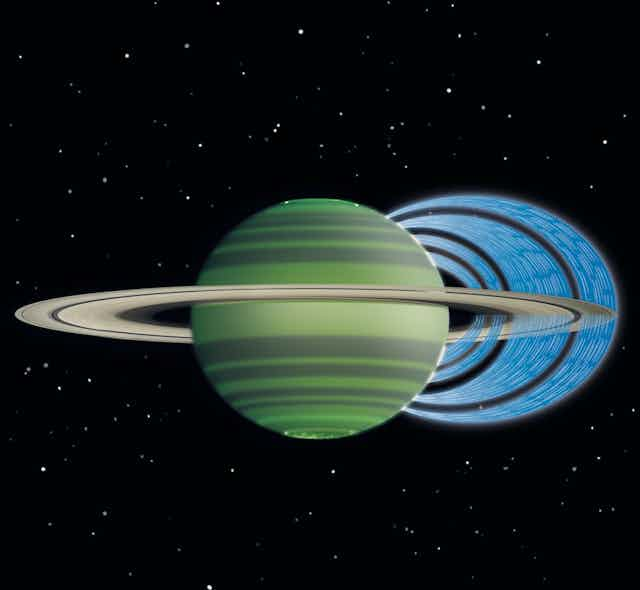In space no one can hear you scream, but you may get a bit wet.
In particular, if you were thinking of journeying to take in the sights of Saturn, it would be a good idea to pack an umbrella.
This is suggested by new observations, published today in Nature, that point to Saturn’s rings being the source of “space rain” that pours down into the planet’s upper atmosphere.
It’s a hypothesis that’s been suggested to explain strange observations of the upper atmosphere of Saturn, the second biggest planet in our solar system.
There has been a long-standing problem that we cannot explain the high temperatures and number of electrons (negatively-charged particles) that are seen in Saturn’s [ionosphere]( (upper atmosphere).
What’s reported today is a neat explanation, coupled with some nifty measurement, which seems to solve this problem.
Rings of ice

Saturn’s rings are arguably one of the most spectacular and recognisable sights in our solar system.
Majestically large and jaw-droppingly beautiful, they also present one of the big mysteries of the solar system.
There’s currently little consensus as to how old they are, with computer models suggesting they formed at the beginning of the solar system.
But this contrasts with observed features that suggest they are being eaten away, and must be a little more recently formed.
Why does it matter?
The origin of Saturn’s rings is a key question in trying to piece together how the whole of our solar system formed.

A full understanding of this process will reveal not only how our planet and it’s companions came about, but also give us clues as to how other solar systems could arise.
Saturn’s rings are mainly made of ice, with lots of different sizes of ice particles that clump then disperse as they are trapped within the rings.
Though the rings are mainly ice, small amounts of other materials, rocks and carbon, cause the changes in colour that we see.
The power of charged water
Our understanding of Saturn’s rings has increased immensely with data collected from the Cassini spacecraft.
What this mission has revealed is that rather than being a static, Saturn’s rings in fact are pretty dynamic systems, spouting jets of materials and being rippled by its moons.
But, as today’s study shows, you don’t necessarily need to be in orbit about Saturn to make some stark discoveries.
This latest finding was has been from the W. M. Keck telescope, two 10-metre mirrors on the top of Mauna Kea in Hawaii (hard life these astronomers have, eh?).
These examined the light from Saturn, taking measurements in strips north to south.
The observers looked at the light signal from the H3+ molecule - the most prevalent molecule in space - as a way to suggest areas where charged water may be falling into the ionosphere.
Charged water is produced when water molecules are exposed to solar radiation or energetic particles.
The H3+ really likes to combine with charged water, so where you see a lack of H3+ suggests areas where there would be an influx of water.
What the researchers saw was that in places, along these north-south strips, there were fewer H3+ ions observed.
Rainy days
So if there’s water arriving in the upper atmosphere of Saturn, where is it coming from?
To answer this the researchers examined Saturn’s magnetic field.
On Earth, our magnetic field is the invisible shield that protects us from the charged particles of interplanetary space.
Each of the gas giants - Jupiter, Saturn, Uranus and Neptune - have magnetic fields, but not all planets have them; for instance, Venus doesn’t.
Saturn’s is particularly intriguing in that it is perfectly symmetric about its own rotation axis (unlike Earth’s).
Following up the magnetic field lines, the regions where there was less of the H3+ ion corresponded with Saturn’s rings.
In fact, regions where more of the H3+ ion was observed matched up with gaps in the rings.

From this, the researchers constructed the theory that charged water is being channelled down the magnetic field (like those awesome Spokey Dokes you had on the spokes of your first bike).
This space rain is a way that Saturn’s rings are being eroded away.
So perhaps humankind has caught them just at their peak, and from here they will slowly rain down into the ionosphere - proving that all beauty is, on some timescale, fleeting.

